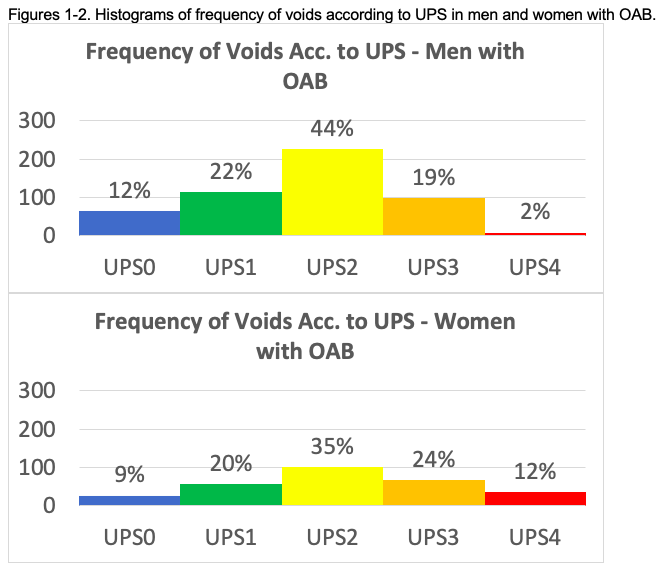Back
Poster, Podium & Video Sessions
Moderated Poster
MP18: Urodynamics/Lower Urinary Tract Dysfunction/Female Pelvic Medicine: Non-neurogenic Voiding Dysfunction I
MP18-05: Extra Voids in Patients with Overactive Bladder
Friday, May 13, 2022
4:30 PM – 5:45 PM
Location: Room 222
Kevin Rychik, New York, NY, Max Edeson, Nutley, NJ, Edward Smith*, New York, NY, Jeffrey Weiss, Brooklyn, NY, Wade Bushman, Madison, WI, Jerry Blaivas, New York, NY

Edward Smith
Research Coordinator
Poster Presenter(s)
Introduction: We previously defined two new bladder diary metrics: the voiding frequency index (VFI) calculated by dividing the 24-hour urine voided volume (24HVV) by the maximum voided volume (MVV), and extra voids index (EVI) calculated as the difference between the actual number of voids in 24 hours (ANV) and VFI rounded down 1. The EVI is therefore a metric for “extra voids,” The purpose of this study was to compare the number of extra voids in patients with OAB to asymptomatic reference patients 2,3, and to characterize and quantify their voids according to urgency based on the Urgency Perception Score (UPS) 4.
Methods: This was a retrospective database study of patients diagnosed with OAB who completed a 24-hour bladder diary (24HBD) and lower urinary tract symptom score questionnaire (LUTSS) using a smartphone app from 2015-2021. Criteria for a diagnosis of OAB were an OAB sub-score of = 8 or = 3 on one or more of questions 3 – 6 of the LUTSS. The ANV, VFI, and EVI values were calculated and compared to the same bladder diary metrics obtained from a cohort of asymptomatic reference patients 2,3. Then, we analyzed 24HBDs from a sub-set of 100 patients with OAB to classify each void according to the UPS, (grade 0 = “convenience voids,” grades 1 & 2 = “non-urgency voids,” grades 3 & 4 = “urgency voids”) and compared the mean UPS in men and women with a two sample t-test.
Results: There were 511 patients in the database of whom 400 had a diagnosis of OAB; 19 were excluded because of erroneous data, leaving a cohort of 381 patients who met all entry criteria. ANV, VFI and EVI were greater in men and women with OAB compared to asymptomatic reference men and women 2,3 (Table 1). When quantified according to UPS, 21% of voids in men were due to urgency, compared to 36% in women [Figures 1, 2]. The mean UPS was greater in women (2.1) than men (1.8) (p <.001).
Conclusions: EVI is a quantitative metric for the extra voids in a 24-hour period. Patients with OAB void about 4 times more daily than patients without OAB, including 2 extra voids, quantified by an EVI of 5 in patients with OAB compared to an EVI of 3 in references. The majority of voids in both sexes are non-urgency voids, although less so in women, and perhaps, conscious or subconscious attempt to ameliorate OAB symptoms. These data may be useful in developing therapeutic strategies including behavioral techniques and new therapies directed at alleviating urinary symptoms as well as prompting greater research into why people void as often as they do.
Source of Funding: None


Methods: This was a retrospective database study of patients diagnosed with OAB who completed a 24-hour bladder diary (24HBD) and lower urinary tract symptom score questionnaire (LUTSS) using a smartphone app from 2015-2021. Criteria for a diagnosis of OAB were an OAB sub-score of = 8 or = 3 on one or more of questions 3 – 6 of the LUTSS. The ANV, VFI, and EVI values were calculated and compared to the same bladder diary metrics obtained from a cohort of asymptomatic reference patients 2,3. Then, we analyzed 24HBDs from a sub-set of 100 patients with OAB to classify each void according to the UPS, (grade 0 = “convenience voids,” grades 1 & 2 = “non-urgency voids,” grades 3 & 4 = “urgency voids”) and compared the mean UPS in men and women with a two sample t-test.
Results: There were 511 patients in the database of whom 400 had a diagnosis of OAB; 19 were excluded because of erroneous data, leaving a cohort of 381 patients who met all entry criteria. ANV, VFI and EVI were greater in men and women with OAB compared to asymptomatic reference men and women 2,3 (Table 1). When quantified according to UPS, 21% of voids in men were due to urgency, compared to 36% in women [Figures 1, 2]. The mean UPS was greater in women (2.1) than men (1.8) (p <.001).
Conclusions: EVI is a quantitative metric for the extra voids in a 24-hour period. Patients with OAB void about 4 times more daily than patients without OAB, including 2 extra voids, quantified by an EVI of 5 in patients with OAB compared to an EVI of 3 in references. The majority of voids in both sexes are non-urgency voids, although less so in women, and perhaps, conscious or subconscious attempt to ameliorate OAB symptoms. These data may be useful in developing therapeutic strategies including behavioral techniques and new therapies directed at alleviating urinary symptoms as well as prompting greater research into why people void as often as they do.
Source of Funding: None



.jpg)
.jpg)